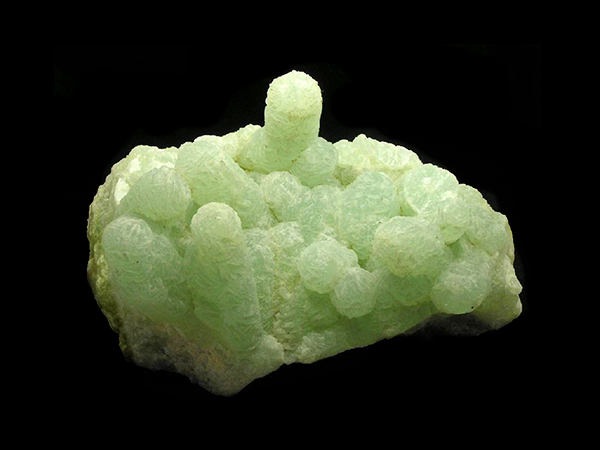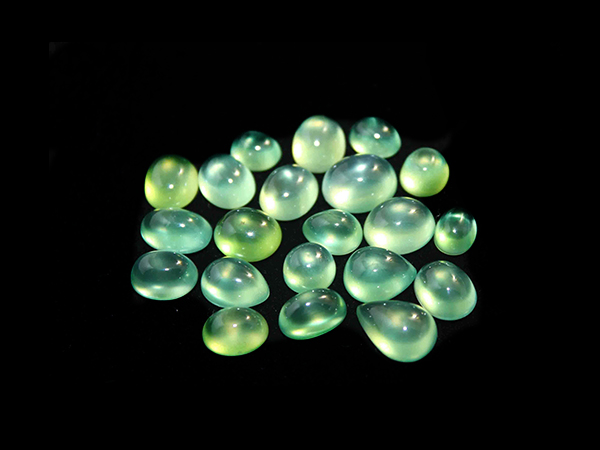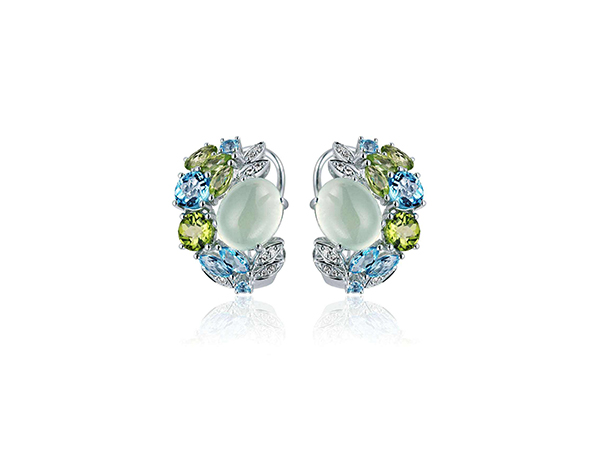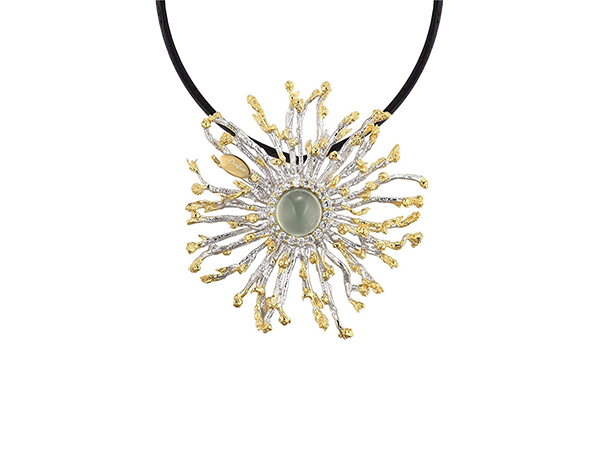GRAPE STONE

They have the shape has the plate shape, the sheet shape, the grape shape, the kidney shape, the radial shape or the massive aggregate and so on.Good quality grape stone can be used as a gem, this gem is known as the cape emerald.
Mineral properties
The optical properties
Common color: white, light yellow, red meat, green, often light
Green and gold are the most precious.
Transparency: transparent to translucent.
Luster: glassy luster.
Optical characteristics: heterogeneous bodies, biaxial crystals, positive light, often a heterogeneous aggregation.
Refractive index: 1.616 ~ 1.649(+ 0.016, -0.031), the point measurement is usually 1.63
Birefringence: 0.020 ~ 0.035, unmeasurable aggregate
Polychromatism: none
Ultraviolet fluorescence: none
Absorption spectrum: 438nm weak absorption band
Special optical effect: cat eye effect (rare)
The chemical characteristics of
Chemical composition: Ca2Al(AlSi3O10)(OH)2, can contain Fe, Mg, Mn, Na, K and other elements.
Chemical classification: silicate
Physical properties
Crystal system: rhombic system.
Crystalline state: crystalline aggregate, usually plate-like, lamellar, grape-like, renal, radial or massive.
A group of complete to medium cleavage: complete cleavage; Medium cleavage, aggregate is usually absent.
Fracture: uneven fracture.
Mohs hardness: 6 ~ 6.5.
Density: 2.80g/cm 3 ~ 2.95g/cm 3.
Others: brittle.
It has the same texture as jinshui bodhi, but the hardness and optical effect are not as good as the former.
Occurrence of origin
Occurrence: graptolite is a secondary mineral formed after hydrothermal alteration, which is mainly produced in the pores and cracks of basalt and other basic ejection rocks, and often co-exists with zeolite minerals, Datolite, calcite and Pectolite.In addition, when some igneous rocks change, the calcium plagioclase in them can also be transformed into grape stone.

Massachusetts, Connecticut, New Jersey, Virginia, Pennsylvania, Michigan, Arizona, California and other states in the United States.
Magnification: fibrous structure, radial arrangement.
When heated, it will foam and turn into white glass.
White striations are also shown.
High quality grape stone will produce similar glass jadeite general "fluorescence", very beautiful, the color of grape stone has dark green - green gray green - green green - yellow green - yellow colorless, occasionally see a gray.But in general, the color of green attune grape stone is yellow or gray tone, yellow attune grape stone, usually the color is bright but not bright with gray tone, rarely appear golden yellow, very rare and precious.
The best grapevines are usually aggregate, dark green.But generally speaking, because of the single crystal cleavage development of this material, so very few single crystal facet, relatively rare.
The common grape stone on the market is mostly colorless grape stone produced in hebei.And mostly for the collection, after processing is very similar to colorless jade.So some merchants will take the high quality grape stone as the substitute of high quality jade, please pay attention to the difference.
Grape stone with clean interior, color pleasing to the eye, large particles and round and full as the price evaluation criteria.Grape stone has been loved by many designers in the world in the past year or two, especially in Taiwan, which has set off a whirlwind. The main reason is that in many natural gemstones with similar appearance to jade, grape stone has the most advantageous conditions.
Grape stone transparent and meticulous texture, elegant light green, water to drop transparency, like the appearance of top ice jadeite, and the price is affordable.
Green garnet and grapevine can be easily distinguished by looking at inclusions.Green garnet is generally rich in strip, needle inclusions, mostly green or black prissy.
Since grapevine is produced under the effect of hot water at relatively low temperatures, it is unlikely that it will grow symbiotically with minerals at high temperatures, and prissy will grow at a relatively high temperature, so it is expected that it will not grow symbiotically with grapevine.So, by looking at the inclusions, you can tell the difference between grapevine and green garnet.

Graptolite prehnite -- Ca2Al[AlSi3O10](OH)2 rhombic system, the crystals are mostly grape-like, stalactitic and granular aggregate.Transparent to translucent, color by yellow-green, brown yellow, gray, white to colorless have.It is the product of hydrothermal alteration of basic plagioclase.
maintenance
Usually clean with water, do not contact alkali.
The hardness of grape stone is low, please pay attention not to rub with hard objects when wearing.
Distribution in ChinaGrape stone, produced in luzhou, leshan and other places in sichuan province.The stone color is more green, stone surface has a raised color block, like grapes, so the name.
Grape stone is fruity and bright and clean, glittering and translucent and lovely, with grain and base color contrast apparent, grain big form is round, show anaglyph shape to also can make graph person is beautiful.Grapevine is made of granule after grinding round by gravel, which is wrapped and petrified again.
Some are formed during diagenesis by high temperature and high pressure geological processes, such as replacement and condensation of rock internal materials.Some grapestones have some structural veins or cracks interspersed in the grape grains, and those that look like the epiphytic branches of plum blossom are called plum blossom stones.
Luzhou grape stone, also known as green stone, produced in luzhou Yangtze river section.Basalt, stone dense, fine and smooth, hard;Most of them are subcircles and ellipses.It is grey, grey-green, light green and grey-black.
There are two kinds of grape grains on the surface of pebble: relief and plane. Generally, the grain color is light and the background color is dark. The composition is clear and the grains are sparse and dense.Especially the green grape stone, known as the green pearl, is of great ornamental value.

Due to the degree of grain is higher than that of wrapped stone, the grain is prominent after water washing and sand grinding.Its grape grains are hard, round, rich in copper and elegant in shades of turquoise.
other
Grape stone is a kind of overseas semi-precious stone, not many people know, but "ice jade" I believe we are more familiar with.
Because the color of grape stone light green and with the jadeite, there are businesses to pass it off as ice kind of jade.In fact, grape stone has its own beautiful, why attach to the "emerald" name.
The difference between grape stone and green green willow, because both are green translucent semi-precious stones, very similar in appearance.The biggest difference lies in the fact that grapevine has a dull, shiny, and slightly green color.
As for weight, there is also a significant difference.Grape stone has a specific gravity of 2.87, which is very close to crystal. A 10MM bracelet has a specific gravity of 22-29-31 grams, and the green green willow (green garnet) with the same bead diameter has a specific gravity of 3.4-3.6, which should exceed 34 grams or even reach 38 grams.
